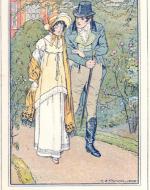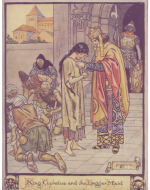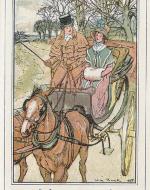Created by Caroline Brown on Thu, 03/21/2024 - 12:54
Description:
Henry Matthew Brock (1875-1960) is an English illustrator known for his vibrant contributions to classic literature, specifically for his illustrative work within children's books and most notably the Jane Austen novels. Brock was born in Cambridge, England and showed expansive artistic knowledge from a young age. Eventually he was able to pursue a formal education at the Cambridge School of Art and later relocated to London to begin his career in illustration. Brock was known for his meticulous attention to detail and richly textured landscapes. His style often implemented elements of realism and romanticism, capturing the essence of novels that he was illustrating. Readers today can rely on Brock to give life to Austen’s well-loved novels. His illustrations for these novels are most notable for his ability to reflect the wit, charm, and social satire of her writing.
This case aims to analyze the development and artistic process of Henry Brock as he becomes a more independent artist from his brother, Charles Brock. The illustrations above aim to show the development of confidence and artistic style of Henry, as he becomes more confident in his own distinct illustrative style. Brock's career as an illustrator flourished within the London setting, as he set foot into the heart of England's publishing industry in the late 19th century. In London he found ample opportunities to showcase his distinctive talent and eventually was able to collaborate with renoweed publishing house Macmillan & Co. He produced a series of wonderfuly illustrated editions of classical novels, including works of Charles Dickens and Sir Walter Scott. As a result, he earned widespead acclaim and recognition. He continued on with his illustrations in classical literature, but also moved to illustrated many fairy tales and adventure stories. He was known for his whimsy, charm, and ability to influence the imagination of his young readers.
Lafayette, Photographic Portrait of Henry Brock, ca. 1926, National Portrait Gallery, Wikipedia. This image of Brock is located in the National Portrait Gallery in London and photographed by Layfayette, who was a notable portrait photographer during the time. It depicts him at his easel, which is where he claims he found the most comfort within his life. Brock was photographed doing what he loved best, and Layfayette aimed to capture Brock at the beginning stages of his creative process, thus allowing us to see Brock in this stoic stance. It was important that Henry was photographed alone, as he is the brother of a better-known artist Charles Edmund Brock, which whom he shared a studio.
Henry Brock and Charles Brock, "Mr. Knightley and Emma Woodhouse," for Emma (1816), by Jane Austen, ca 1898, Molland's Public Library. This illustration depicts Mr. Knightley and Emma Woodhouse, and it is one of the many illustrations in Jane Austen's Emma that Henry Brock contributed to. Henry and his brother, Charles Brock, worked directly with Jane Austen's novels to create illustrations that visually transport readers into her works. The illustration above can be attributed to the Brock brothers by stylistic features, such as their keen eye for fashion sense during this period, the social customs of the novel, and how attire reflects the surroundings that the characters are inhabiting during the scene. Charles Brock specifically focused on body language and facial expressions to bring out the true feelings of each of the characters. We can see in the image that all of these elements come together to display Mr. Knightley and Emma Woodhouse as they take a walk through the gardens. This scene shows much romance, as Charles Brock does a wonderful job of getting details such as the handholding, and the bodies of the two characters leaning into each other for comfort. These small moments exemplify the illustrations, and show why Charles was so widely in demand as an illustrator during the Victorian age.
Henry Brock, "King Cophetua and the Beggar Maid," for The Book of Old Ballads, ca. 1934, Wikipedia. This illustration depicts one of Henry Brock's illustrations for the popular ballad, "King Cophetua and the Beggar Maid." This ballad became a popular children's story that was illustrated by many famous artists, but among the most popular is the illustration that Brock created. This image emphasizes Brock's powerful color work, which was one of his notable skills as an artist of this time. He found his color work to be especially successful within the children's realm of literature, as children were drawn to the vibrancy of the pictures, helping them visualize the stories in new ways. This illustration is located in A Book of Old Ballads, which contains some of the most popular stories of the time period. Henry's father, Charles Edmund Brock, was an expert in medieval languages and oriental languages. Along with his guidance, Henry was able to contruct his images to be culturally appropriate. Using the correct colors and physical appearances was important to both him and his father. Henry had his family model for the picture wearing different garments, so he was able to get the correct color pallet and be able to correctly illustrate the way the clothing draped on individual's bodies. This image, being one of his most famous, is some of his best work as it showcases all of Henry's illustrative talents within one image. Along with seeing the image, having the background surrounding his creative process allows the reader to truly enjoy the love and intensity that went into his creative processes.
Henry Brock, "Henry Drove so Well," for Northanger Abbey (1818), by Jane Austen, ca. 1898, Wikipedia. Henry Brock's illustrations for Jane Austen's Northanger Abbey are notable for their ability to capture the essence of the characters and settings depicted in the novel. This illustration shows Brock's illustrative focus on key scenes and characters, using expressive detail and gestures. He is able to masterly depict Catherine Morland, who is a young girl full of innocence, though paired with a lively imagination. This illustration shows how Henry Tilney and Catherine Morland ride along in the countryside of Bath, depicting not only the beautiful countryside but the social intricacies of courting and Bath society. We see the respect between both Henry and Catherine, as they sit peacefully right next to each other on the carriage itself. Brock's attention to detail extends beyond the characters to the setting as well. Henry pays close attention to the Bath countryside, to evoke the atmosphere of Austen's world, providing a visual aid to the wonderful prose set up by Austen. Henry aimed to depict the true innocence of Catherine and to highlight her sense of adventure as she ventures into becoming a married woman of society.
"Brock Collection." University of Reading Speacial Collections, URL: https://collections.reading.ac.uk/special-collections/collections/brock-collection/
"Henry Matthew Brock: Biography." MutualArt, URL: https://www.mutualart.com/Artist/Henry-Matthew-Brock/7260DC6F9BB264DB/Biography
Brock, Henry Matthew. Project Gutenberg, URL: https://www.gutenberg.org/ebooks/author/32971
"Illustrations by Henry Matthew Brock." Victorian Web, URL: https://www.gutenberg.org/ebooks/author/32971





